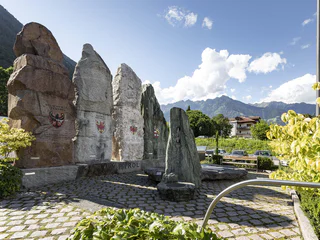
Fruit and Vegetable Market
Bolzano Centro/Bozen Zentrum, Bolzano/Bozen, Bolzano/Bozen and environs
Zuid-Tirol is bijzonder rijk aan verhalen die zich slingeren rond geheime locaties en ongewone natuurlijke formaties. Bezienswaardigheden, zoals de heksenbankjes op de Alpe di Siusi/Seiser Alm, vertellen verhalen van heksen en koningen, terwijl krachtplekken, zoals de "Stoanerne Mandln" met meer dan honderd cairns of de oude ruïnes op de heuvel van Castelfeder, bezoekers uitnodigen om te ontspannen en diep adem te halen. Unieke natuurlijke formaties zoals de aardpiramides zijn plaatsen die een wandeling en verkenning waard zijn.

Bolzano Centro/Bozen Zentrum, Bolzano/Bozen, Bolzano/Bozen and environs

Gomagoi/Gomagoi, Stilfs/Stelvio, Vinschgau/Val Venosta

1/3
Marlengo/Marling, Marling/Marlengo, Meran/Merano and environs

1/3
Anterselva di Mezzo/Antholz-Mittertal, Rasen-Antholz/Rasun Anterselva, Dolomites Region Kronplatz/Plan de Corones

Lasa/Laas, Laas/Lasa, Vinschgau/Val Venosta

1/4
Luson/Lüsen, Lüsen/Luson, Brixen/Bressanone and environs

1/6
Laces/Latsch, Latsch/Laces, Vinschgau/Val Venosta

1/6
Badia/Badia, Badia, Dolomites Region Kronplatz/Plan de Corones

1/3
La Val/La Val, La Val, Dolomites Region Alta Badia

1/3
Andriano/Andrian, Andrian/Andriano, Alto Adige Wine Road

La Costa/Seit, Laives/Leifers, Bolzano/Bozen and environs

1/2
Villa/Vill - Rodengo/Rodeneck, Rodeneck/Rodengo, Brixen/Bressanone and environs

1/3
Prati/Auen, Sarntal/Sarentino, Meran/Merano and environs

1/7
Ortisei/Urtijëi/St. Ulrich/Urtijëi, Urtijëi/Ortisei, Dolomites Region Val Gardena

1/4
Badia/Badia, Badia, Dolomites Region Alta Badia

Merano/Meran, Meran/Merano, Meran/Merano and environs

Auna di Sotto/Unterinn, Ritten/Renon, Bolzano/Bozen and environs

Alpe di Rodengo/Rodenecker Alm, Rodeneck/Rodengo, Brixen/Bressanone and environs

1/4
Monguelfo/Welsberg, Welsberg-Taisten/Monguelfo-Tesido

1/3
S. Genesio Atesino/Jenesien, Jenesien/San Genesio Atesino, Bolzano/Bozen and environs

1/2
Lappago/Lappach, Mühlwald/Selva dei Molini, Ahrntal/Valle Aurina

1/2
Plars di Mezzo/Mitterplars, Algund/Lagundo, Meran/Merano and environs

Sexten/Sesto, Dolomites Region 3 Zinnen

1/2
Pinzano/Pinzon, Truden/Trodena

Bolzano Centro/Bozen Zentrum, Bolzano/Bozen, Bolzano/Bozen and environs

Stulles/Stuls, Moos in Passeier/Moso in Passiria, Meran/Merano and environs

1/5
Naz/Natz, Natz-Schabs/Naz-Sciaves, Brixen/Bressanone and environs

1/3
Giovignano/Tschiffnon, Feldthurns/Velturno, Brixen/Bressanone and environs

1/2
Valdaora di Sopra/Oberolang, Olang/Valdaora, Dolomites Region Kronplatz/Plan de Corones

Sesto/Sexten, Sexten/Sesto, Dolomites Region 3 Zinnen